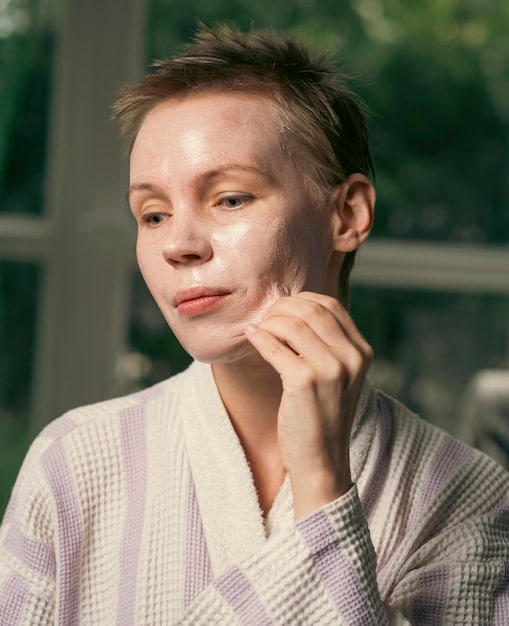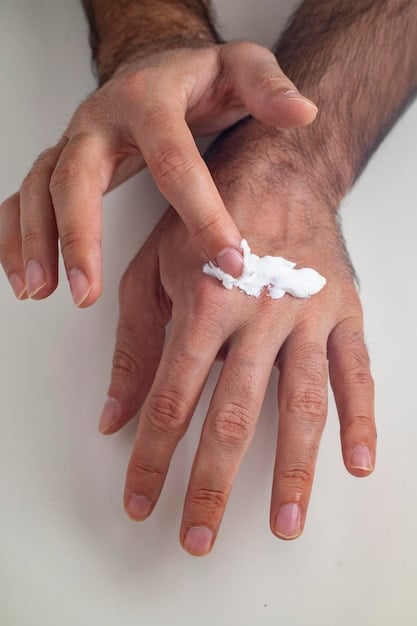Dry Skin Relief: Hydrating Routine Restores Moisture in 7 Days

Dry skin relief can be achieved through a dedicated hydrating skincare routine, involving gentle cleansers, hyaluronic acid serums, rich moisturizers, and weekly masks to restore moisture and alleviate dryness in about 7 days.
Is your skin feeling tight, itchy, and uncomfortable? You don’t have to suffer any longer. Discover the power of a hydrating skincare routine designed to bring you rapid dry skin relief: A hydrating skincare routine that restores moisture in 7 days.
Understanding Dry Skin: Causes and Symptoms
Dry skin can be more than just a cosmetic concern; it can be uncomfortable and even lead to other skin problems. Understanding the underlying causes and recognizing the symptoms is the first step toward effective relief.
Common Causes of Dry Skin
Many factors contribute to dry skin, ranging from environmental conditions to lifestyle choices. It’s important to identify potential triggers to tailor your skincare routine effectively.
- Environmental Factors: Harsh weather, low humidity, and prolonged exposure to sun or wind can strip your skin of its natural oils.
- Lifestyle Choices: Frequent hot showers, using harsh soaps, and not drinking enough water can all contribute to dryness.
- Underlying Conditions: Eczema, psoriasis, and other skin conditions can exacerbate dry skin symptoms.
Recognizing the Symptoms
Knowing the signs of dry skin can help you identify the problem early and take appropriate action. Here are some common symptoms:
- Tightness: A feeling of skin tightness, especially after showering or cleansing.
- Itchiness: Persistent itching can be a sign that your skin is lacking moisture.
- Flakiness: Visible flakes or scales on the skin’s surface.
- Redness: Irritation and redness, particularly in sensitive areas.
By being aware of the causes and symptoms of dry skin, you can take proactive steps to protect and hydrate your skin. This knowledge will help you choose the right products and practices for your specific needs.
The Ultimate Hydrating Skincare Routine: A 7-Day Plan
Creating an effective skincare routine is essential for combating dry skin. This 7-day plan is designed to deliver intense hydration and restore your skin’s natural moisture barrier.
Day 1-2: Gentle Cleansing and Hydration Boost
Start your week with gentle cleansing and an extra boost of hydration to prep your skin. This sets the stage for deeper moisturization in the following days.
- Morning: Use a hydrating, sulfate-free cleanser to gently remove impurities without stripping natural oils. Follow with a hyaluronic acid serum to draw moisture into the skin.
- Evening: Double cleanse with an oil-based cleanser followed by a hydrating cleanser. Apply a rich, ceramide-based moisturizer to lock in moisture overnight.
Day 3-5: Intense Moisturization and Repair
Focus on intense moisturization and repairing your skin’s barrier. These days are crucial for rebuilding hydration levels.

- Morning: After cleansing and serum application, use a facial oil rich in fatty acids to nourish and protect the skin throughout the day.
- Evening: Apply a thick layer of moisturizing cream or hydrating mask and leave it on for 20-30 minutes before rinsing. Follow with your regular moisturizer.
Day 6-7: Maintenance and Protection
Maintain your progress by continuing your hydrating routine and protecting your skin from environmental stressors. Consistency is key to long-term relief.
- Morning: Continue with your hydrating cleanser, serum, and moisturizer. Apply a broad-spectrum sunscreen with an SPF of 30 or higher to protect against sun damage.
- Evening: Repeat your evening routine, focusing on hydration and repair. Consider using a humidifier in your bedroom to add moisture to the air while you sleep.
By following this 7-day hydrating skincare routine, you can effectively combat dry skin and restore your skin’s natural radiance. Remember to listen to your skin and adjust the routine as needed to meet your specific needs.
Choosing the Right Products for Dry Skin
Selecting the right skincare products is crucial when dealing with dry skin. Look for ingredients that hydrate, nourish, and protect your skin’s moisture barrier.
Key Ingredients to Look For
Certain ingredients are especially effective when it comes to hydrating and soothing dry skin. Incorporate these into your daily routine for optimal results.
- Hyaluronic Acid: A powerful humectant that attracts and retains moisture in the skin.
- Ceramides: Lipids that help to repair and strengthen the skin’s natural barrier.
- Glycerin: Another humectant that draws moisture from the air into the skin.
- Shea Butter: An emollient that softens and smooths the skin, providing deep hydration.
Ingredients to Avoid
Some ingredients can exacerbate dry skin. Steer clear of products containing these to prevent further irritation and moisture loss.
- Alcohol: Can be drying and irritating, especially in high concentrations.
- Fragrances: Often contain irritants that can worsen dry skin symptoms.
- Sulfates: Harsh detergents that strip the skin of its natural oils.
By choosing products with hydrating ingredients and avoiding harsh chemicals, you can create a skincare routine that effectively combats dry skin. Always read labels carefully and test new products on a small area of skin before applying them to your entire face.
Lifestyle Adjustments for Dry Skin Relief
In addition to a dedicated skincare routine, lifestyle adjustments play a vital role in managing dry skin. Simple changes to your daily habits can make a significant difference.
Hydration from Within
Drinking plenty of water is essential for overall skin health. Staying hydrated helps to maintain moisture levels from the inside out.
Aim to drink at least eight glasses of water per day. You can also incorporate hydrating foods like cucumbers, watermelon, and spinach into your diet. These foods are rich in water and nutrients that support healthy skin.
Shower and Bath Habits
Hot showers and long baths can strip your skin of its natural oils. Modify your routine to protect your skin’s moisture barrier.

Opt for warm, not hot, water when showering or bathing. Limit your time to 10-15 minutes to prevent excessive moisture loss. Use a mild, hydrating body wash instead of harsh soaps. Pat your skin dry gently and apply a moisturizer immediately after showering to lock in moisture.
Humidify Your Environment
Dry air can worsen dry skin symptoms. Using a humidifier, especially during the winter months, can help to maintain moisture levels in your home.
Place a humidifier in your bedroom to add moisture to the air while you sleep. This can help to prevent your skin from drying out overnight. Clean your humidifier regularly to prevent the growth of mold and bacteria.
By making these lifestyle adjustments, you can create an environment that supports healthy, hydrated skin. Remember, consistency is key. Incorporate these changes into your daily routine for long-term relief from dry skin.
DIY Remedies for Extra Dry Skin
Sometimes, your skin needs an extra boost of hydration. DIY remedies can provide that extra care using ingredients you likely already have at home.
Avocado and Honey Mask
Avocado is rich in healthy fats and vitamins, while honey is a natural humectant and antibacterial agent. Together, they make a deeply hydrating mask.
To make the mask, mash half an avocado and mix it with one tablespoon of honey. Apply the mixture to your face and leave it on for 15-20 minutes. Rinse with warm water and pat your skin dry. This mask is perfect for providing intense hydration and soothing irritated skin.
Oatmeal Bath
Oatmeal has anti-inflammatory properties and can help to relieve itching and irritation associated with dry skin. An oatmeal bath is a gentle and effective way to soothe your skin.
Grind one cup of plain oatmeal into a fine powder. Add the powder to a lukewarm bath and stir well to ensure it is evenly distributed. Soak in the bath for 15-20 minutes. Pat your skin dry gently and apply a moisturizer immediately after. This remedy is particularly helpful for relieving itchiness and inflammation caused by dry skin.
By incorporating these DIY remedies into your skincare routine, you can provide your skin with an extra dose of hydration and relief. These natural treatments are gentle, effective, and can be easily customized to suit your specific needs.
When to See a Dermatologist
While many cases of dry skin can be managed with a dedicated skincare routine and lifestyle adjustments, some situations warrant professional medical attention.
Persistent Dry Skin
If your dry skin persists despite your best efforts, it may be a sign of an underlying condition that requires diagnosis and treatment.
If you have tried various moisturizers, lifestyle adjustments, and DIY remedies without seeing improvement, consult a dermatologist. They can assess your skin condition and recommend prescription-strength treatments or further testing to identify the cause of your dry skin.
Signs of Infection
Dry, cracked skin can create openings for bacteria and other pathogens to enter, leading to infection. Seek medical attention if you notice any signs of infection.
Look for symptoms such as redness, swelling, pus, or increased pain in areas of dry skin. These signs may indicate a bacterial infection that requires antibiotic treatment. A dermatologist can diagnose and treat skin infections effectively.
Knowing when to seek professional help is crucial for managing dry skin effectively. Don’t hesitate to consult a dermatologist if you have concerns about your skin’s health or if your symptoms are not improving with self-care measures. They can provide expert guidance and treatment options to help you achieve healthy, hydrated skin.
| Key Point | Brief Description |
|---|---|
| 💧 Hydration | Use hyaluronic acid and glycerin to attract moisture. |
| 🛡️ Protection | Apply sunscreen daily to shield skin from sun damage. |
| 🛁 Gentle Cleansing | Opt for sulfate-free cleansers to maintain natural oils. |
| 🥑 DIY Masks | Try avocado and honey masks for intense moisture. |
Frequently Asked Questions
▼
Exfoliate dry skin gently and sparingly, no more than once or twice a week, to avoid irritation. Use a mild chemical exfoliant or a soft washcloth with a hydrating cleanser.
▼
Yes, diet plays a crucial role. A diet rich in essential fatty acids, vitamins, and antioxidants can support skin hydration. Include foods like avocados, nuts, and oily fish in your meals.
▼
Absolutely. Sunscreen protects dry skin from further damage and moisture loss caused by UV rays. Choose a broad-spectrum sunscreen with hydrating ingredients, like ceramides or hyaluronic acid.
▼
Opt for a thick, emollient moisturizer containing ingredients like shea butter, ceramides, and hyaluronic acid. These help to repair the skin barrier and lock in moisture effectively.
▼
Combat winter dryness by using a humidifier, avoiding hot showers, and applying a richer moisturizer. Layering hydrating serums and oils under your moisturizer can also provide extra protection.
Conclusion
Achieving dry skin relief within 7 days is entirely possible with a consistent and hydrating skincare routine. By understanding the causes, choosing the right products, and making necessary lifestyle adjustments, you can restore your skin’s natural moisture barrier and say goodbye to dryness and discomfort. Remember to listen to your skin, adjust your routine as needed, and seek professional help when necessary.





